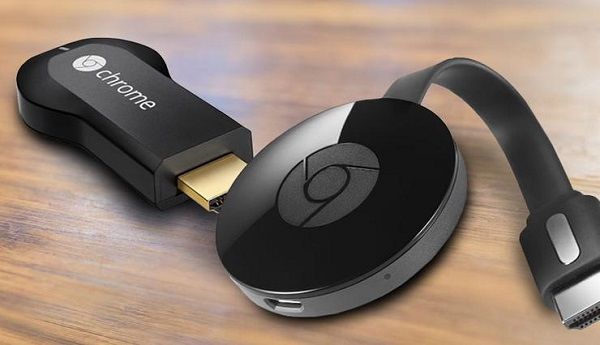
Chromecast is a video streaming device manufactured by Google that can be used to stream images and video to a TV. It is being promoted as a repurposed solution for digital signage, for use in conjunction with any television and a phone, tablet or PC.
How it works
The Chromecast device is connected to a TV on its HDMI port and attached to a power source using a USB cable which can be plugged into the TV for power or use a wall adapter. Using a phone, tablet or PC, you can ‘cast’ your content from that screen to your TV, to which you have connected the Chromecast device.
The Chromecast hardware itself is a ‘dumb’ device and acts as a transmitter of data while having no capability to store or process information. It is dependent a 100% on the hardware (phone, tablet or PC) that is feeding the video or pictures and cannot sequence or store any of that information on itself.Cost of Chromecast
Digital Signage requires content to be displayed on a TV which could involve the display of menu boards, advertisements, promotions, events, schedules, news and weather using images and video. This digital signage content needs to be customized and built based on what the target audience is, and it should also meet the signage owners and customers’ expectations.
Using Chromecast for digital signage requires that the screen owner is well conversant with content creation techniques or has access to specialized graphic designers; who can create this specialized signage content.
Also, the screen owner must also provide for a dedicated tablet or PC for use as a source of content for transmission to the signage TV via Chromecast.Pros of Chromecast digital signage
- It is a low-cost device if you already have an existing tablet or PC that you can dedicate for your digital signage setup using Chromecast.
- Using Chromecast does not require any technical expertise.
- It is a small device and does not require any installation – it just plugs into the TVs HDMI port.
- Being a 'dumb' device, as does not have any processor or storage, there is not much to go wrong with it.
Cons of Chromecast digital signage
- Chromecast being a 'dumb' device requires additional equipment such as a tablet, phone or PC to feed it content.
- Can get expensive as it requires a tablet or PC to feed it content and the additional cost can be a factor if a new tablet or PC needs to be purchased.
- Chromecast requires the use of Wi-Fi internet access and will not function in its absence. In some instances, you could use your mobile data plan, but the eventual cost of bandwidth will be high as you will constantly be streaming images and video.
- Chromecast does not include any scheduling or CMS (Content Management System) software and requires the purchase of additional software that would be used to manage this content.
- The digital signage display will have to be stopped to make any changes to the content as it does not have the ability to update itself while displaying content concurrently. Lack of this capability can be a major inconvenience and also a cause of embarrassment.
- Using a solution like Chromecast would require you to work with graphic designers who will create content for your screen, unlike some solutions that come with ready-to-use digital signage templates that can be modified and displayed quickly – without having to pay for expensive designers.
- As there is no CMS included, displaying content that rotates and loops can be a challenge.
- Similarly showing live content such as news and weather that need to refresh periodically is also a challenge as there is no way to update the screen – unless the update is done manually.
- There is no way to schedule content to play at specific times of day, such as dayparting for digital menu boards, where you need to display unique content for breakfast, lunch, and dinner.
- There is no built-in reporting system that can let you know what content played at what time.
- There is no ready support as a composite solution for using Chromecast for digital signage – it is just available as a tool that can be repurposed as a digital signage solution.
Summary
All said and done, Chromecast as a digital signage solution is viable for a small business who has limited resources and relatively unsophisticated digital signage requirements. It could work well in situations where someone needs to display a static signage that is not time sensitive or does not require any quality of custom designed content.
Being a low-cost solution, it could be a starting step for someone who already has a TV and a tablet with consistent Wi-Fi internet connection. They could start off with a Chromecast transmitter and invest subsequently on a professional solution, once they have realized what they can achieve with their screen and how they can further improve their TV screen utilization, by using a more sophisticated solution.
That being said, solutions like doPublicity offer a composite digital signage solution that includes Media Player and Content Management System at a one-time cost of $399, with no monthly or annual fees. doPublicity’s Content Management System also includes over 1,000 ready-to-use templates that can be used for displaying digital menu boards, advertisements, promotions, events, and weather. Also, content can be scheduled for display by segmenting it by hour of the day, the day of week or start and end dates. This system does not require multiple pieces of hardware and uses just a Media Player for each TV, which can be managed remotely using any phone, tablet or PC (which does not have to be a dedicated unit) from anywhere – home or office.